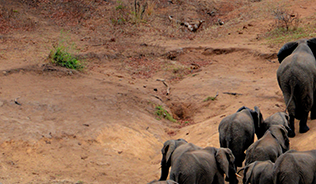Environmental Impact Assessment (EIA) professionals play an integral role in developments, ensuring that deleterious environmental impacts are minimised. Influencing projects at the design stage is key to ensuring better environmental outcomes from projects, but how can interdisciplinary collaboration between the different stakeholders involved in project development be facilitated to ensure this?
Our latest EIA Community Debate, held in collaboration with the Institution of Civil Engineers (ICE), explored this question, as well as the wider question of what makes good design. This event was organised following discussion at a previous EIA Community Debate: EIA for better design.
Defining good design
Judith Sykes, Senior Director of Expedition Engineering and Fellow of ICE, explored what was meant by "good design" and provided case study examples of projects which highlighted different facets of good design, including the Olympic Park development and London Bridge Station redevelopment.
Judith highlighted that the difficulty of formulating a definition for good design rests on the multitude of stakeholders involved, with good design often meaning different things to different people. There are however a number of common characteristics between projects which exhibit good design that Judith raised – design is a process and, as such, for the best outcomes this process should be iterative in nature, providing opportunities for input from different stakeholders. Ensuring that the project is based around a good understanding of need and a strong design brief are also important factors for ensuring good design.
Watch the presentation here (start to 13mins)
Influencing design
In order for different professionals to input into design, there needs to be a good understanding of the different stages within the design process, so that professionals working in different sectors can identify opportunities for influencing the design process.
Eleni Antoniades Snell, Project Environmental Lead and Vice Chair at the IES, looked at each of the design stages in detail, exploring the different ways that environmental and engineering professionals could feed into the process.
Watch the presentation here (13 mins to 27 mins)
Barriers to collaboration
Collaboration between engineering and environmental teams is vital to securing good design outcomes which work for people and planet. Interdisciplinary collaboration can be challenging, however. Through discussion, the following barriers to collaboration were identified:
- Communication – good communication methods and using a common language between stakeholders is a key requisite for effective interdisciplinary working.
- Culture – a collaborative culture which doesn’t see the different design stages as a tick-box exercise but rather as an opportunity for improvement will support good design.
- Budget – allowances in the budget to support collaboration and buy-in from the client are vital for successful collaboration.
- Time – projects often have lots of milestones and related time pressures. If not enough opportunities for inputs are programmed in, this can hinder collaboration. It’s also important to ensure relevant specialists are brought in at the relevant times.
To try and facilitate collaboration and overcome these barriers the following solutions were raised:
- Hold a workshop early in the project lifecycle to bring the key stakeholders together and establish a common language and ways of working. Highlighting the key environmental considerations at this stage is also important so that the design can take these into account from the outset.
- Move the focus away from risk and towards opportunity to reframe the discussions.
- Articulate to clients the value of collaborative working to support buy-in.
- Make use of relevant digital platforms, for example giving all relevant stakeholders access to a Teams account can help make sure they have access to information sources and can communicate easily with stakeholders.
- Develop best practice guidance for stakeholder engagement at the different design stages.
Principles of good design
The National Infrastructure Commission (NIC) published four principles of design for national infrastructure in 2020:
- Climate – mitigate greenhouse gas emissions and adapt to climate change.
- People – reflect what society wants and share benefits widely.
- Places – provide a sense of identity and improve our environment.
- Value – achieve multiple benefits and solve problems well.
Following the publication of these principles, the ICE surveyed their membership to explore how well they were understood and whether they were used in practice. The results from this survey are available in the ICE’s What makes good design? report. The survey results highlighted some key factors that were preventing engineers from considering the four design principles holistically, including an industry perception that it adds time and money, a lack of joined-up thinking on projects, and a limiting brief.
Two of the key recommendations from the ICE were the need to define what makes a good design brief and the role of design champions, in collaboration with other institutions and industry representatives. In 2020 the Government announced that there should be a board-level design champion for all major infrastructure projects, following the NIC’s recommendation, further reinforcing the need for defining the role and qualities of a design champion.
Find out more about the results in Judith Sykes presentation (27 mins to end)
Discussion then took place between IES and ICE members to explore the qualities of a good design brief and design champion. It was noted that it is the responsibility of all professionals involved in the design process to champion the principles of good design.
What makes a good design brief?
- The need for the scheme should be at the centre of a good design brief – why is the scheme happening? What is its purpose? What are its drivers, both nationally and internationally? What are the deliverables?
- The design brief should be value-led, in terms of value to people and planet.
- The design brief should contain details of technical elements and cover the broad spectrum of environmental topics, e.g., climate adaptation, air quality, ecological concerns etc. The brief should contain details of what needs to be included, as well as what doesn’t need to be included.
- The design brief needs to be broad enough to not introduce too many constraints.
- The design brief should be informed by all relevant stakeholders, making sure they are engaged at the right time in its design.
What makes a good design champion?
- A design champion needs to be a strong communicator, with the ability to seamlessly communicate with stakeholders across disciplines.
- A design champion should be able to take a holistic overview of a scheme and be confident in applying systems thinking.
- A design champion should have a good understanding of the overall design process and the stages at which different stakeholders should be engaged.
- A design champion should make sure to ask the right questions at the right time and know when to seek further expertise.
- A design champion should have relevant technical experience for the scheme in question.
- A design champion should have several qualities, including being pragmatic and innovative.
- A design champion should have skills in managing conflict, and not be afraid to challenge stakeholders.
Read more about the ICE's work in defining and developing the Design Champion role
Next steps
This event highlighted the need for further collaborative work between professions involved in the design and planning of projects. In particular there is need to develop common frameworks across professions to support the development of good design briefs and further work in supporting professionals to become design champions.
Communication skills and the need for systems thinking have been a common thread running through many of the discussions and supporting interdisciplinary fora and training will be key to addressing these barriers. Supporting a collaborative ethos between members of design teams is also critical.
Showcasing best practice case studies of good design will also aid in upskilling professionals, as well as demonstrate the value of good design to clients and help secure client buy-in and foster a culture conducive to design which benefits people and planet.





